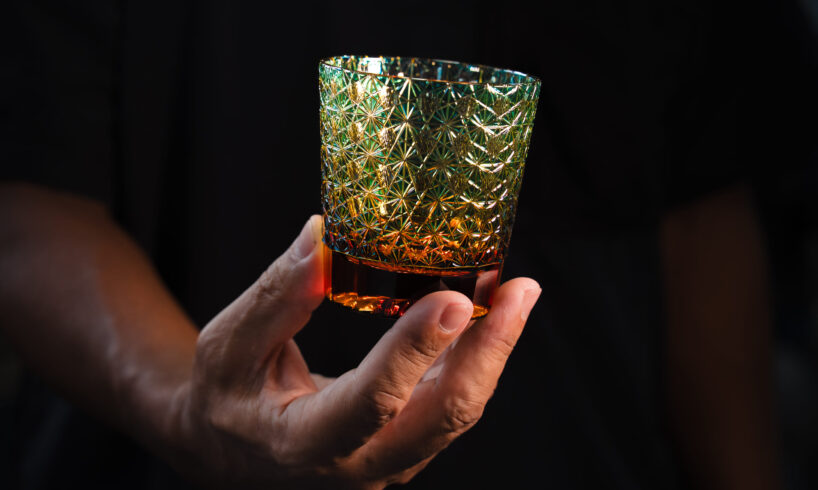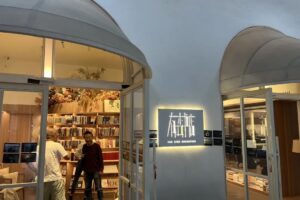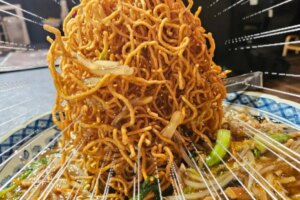
Edo kiriko is glass transformed. Using diamond wheels, this nearly two-hundred-year-old Tokyo craft carves clear or colored glass into intricate patterns that catch and fracture sunlight, turning everyday vessels into luminous works of art. Each line, curve and motif is cut by hand, a rhythm of precision and patience passed down through generations.
For over a century, Edo kiriko has been a prized luxury in Japan, celebrated for its craftsmanship and elegance. Yet despite its long history, it feels strikingly modern: crisp geometric cuts, subtle gradations and occasional bold splashes of color give each piece a sense of contemporary sophistication.
These hand-carved works are distinctly Japanese, officially designated as a traditional craft of Tokyo, and remain rare and difficult to find outside the country. The online shop Koikiya Tokyo aims to change that. Through this service, collectors and enthusiasts around the world can now experience the brilliance of Edo kiriko, bringing home a piece of Tokyo’s heritage and refined craftsmanship.
Tradition and Craftsmanship at Your Fingertips
Koikiya Tokyo is an online shopping site operated by the Tokyo Metropolitan Government, offering traditional crafts for domestic and international customers. The platform carries a variety of Edo kiriko wares, each crafted by master artisans dedicated to preserving this timeless art.
Among the offerings are the delicate works of Harisho Yamada Glass, a workshop in Tokyo’s Sumida ward that has shaped Edo kiriko for four generations. Masaaki Yamada, the current head of the workshop, works alongside his father and young son, maintaining traditional techniques while introducing new motifs and modern color schemes. The workshop produces a range of mesmerizing patterns, each piece reflecting meticulous craftsmanship.
Through Koikiya Tokyo, these exceptional works are no longer confined to the workshop — collectors worldwide can bring home a piece of Edo kiriko with ease.
Edo Kiriko: A Craft Rooted in History
Edo kiriko traces its roots to the early 19th century, when artisans in Edo (today’s Tokyo) began experimenting with cutting techniques on imported glass from the West. Over time, the practice developed into a distinctive style: clean geometric cuts, delicate motifs and a brilliance that captures light in motion.
Since its founding over 80 years ago, Yamada Glass has passed down traditional Edo kiriko techniques while also innovating along the way. An example is the hana kiriko technique — independently developed by Yamada Glass — which creates subtle gradations by pressing glass against a rotating disk. With this softer style, it’s possible to create lifelike animal and floral motifs, like Yamada’s signature cherry blossoms.
One of the most distinctive features of Yamada Glass is the use of yukari tsunagi, a pattern of overlapping lines and circular reflections symbolizing connection and destiny. This is used in a design that references Hokusai’s famed woodblock print, the dramatic Rainstorm Beneath the Summit.
Among Yamada’s personal favorites is seigaiha, or “blue ocean waves,” a motif with origins in ancient Persia that reached Japan along the Silk Road. Not all patterns are traditional, however — some are playful, like the mizutama mangekyou, or “polka-dot kaleidoscope.”
The Making of Edo Kiriko
The creation of Edo kiriko demands precision and plenty of patience. Each Harisho Yamada piece is made of glass blown in Hokkaido, brought to Tokyo for finishing. From there, Yamada takes the blank vessel and cuts into it with diamond wheels, etching patterns with painstaking accuracy. One slip and the work is lost. The final polishing, perhaps the most demanding stage, requires complete focus to bring out the glass’s transparency and luster.
An intricate glass can take nearly a full day to complete. On average, Yamada produces five or six pieces daily. “When I first began, I had to concentrate intensely just to make straight lines, and the movements are repetitive, so I would struggle staying awake at times,” he recalls with a laugh. “Now, after years of practice, my hands know the movements. I can even chat with my father or son while working. Every part of the process is enjoyable.”
Contrary to their delicate appearance, Edo kiriko glasses are surprisingly substantial and durable — not merely objects of beauty, but also practical enough for everyday use, whether at the dining table or during an evening drink.
When he demonstrated and sold the glasses overseas, Yamada recalls, many visitors paused to admire the intricate craftsmanship and distinctive sparkle. From these experiences, he’s convinced that Edo kiriko has the power to convey its charm beyond words.
“If Edo kiriko becomes more widely known and used in daily life overseas, more people will realize how well it complements Japanese whiskey and sake,” he says. He dreams of the day when Edo kiriko, blending Japanese aesthetics with practicality, graces tables around the world.
Discover Edo Kiriko with Koikiya Tokyo
Bring the brilliance of Edo Kiriko into your home through Koikiya Tokyo, a curated destination for stylish traditional crafts from Tokyo.
Explore the full Edo Kiriko collection, or discover the artistry of Yamada Glass.





